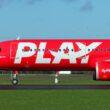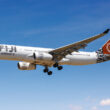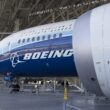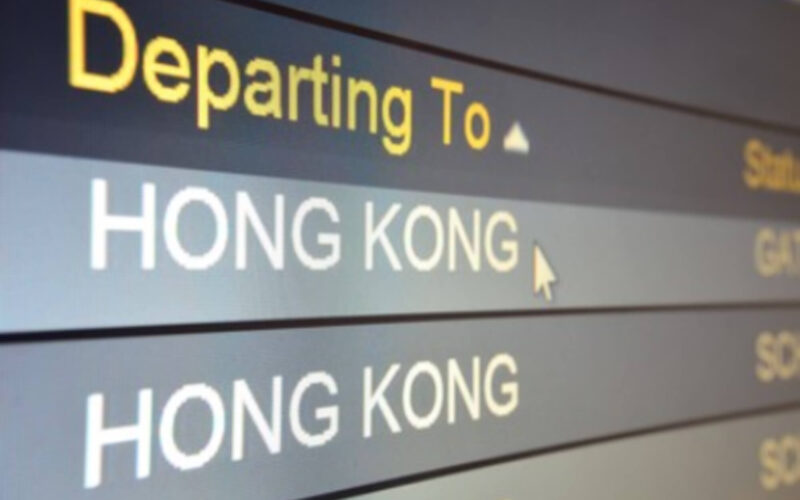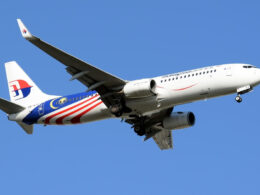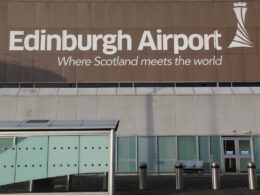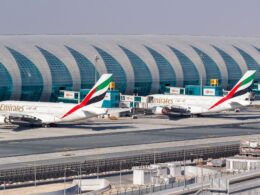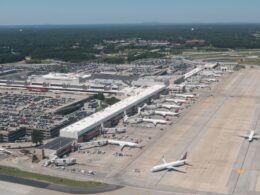Throughout the early and mid-2010s, Hong Kong International Airport (HKG) was a staple among the top 10 largest airports in the world.
The hub, served mainly by Cathay Pacific, thrived as a connecting bridge between several continents and southern China, as well as South East Asia, enabling passengers to reach one of the world’s largest finance hubs and other metropolitan areas a stone’s throw away from Hong Kong.
The airport also flourished as a cargo destination, consistently ranking as the number one airport by total cargo tonnage globally, enabling a symbiotic relationship between the airport and Cathay Pacific, an airline that is synonymous with HKG.
But both the city’s and the airport’s status as a global hub began to change. While instinct would be to blame the pandemic and China’s – as well as Hong Kong’s – strict zero-COVID policies, city-wide protests in early 2019 began to affect the airport’s status as Asia’s premier hub.
And then, as passenger demand began to recover, competition emerged with the ability to topple HKG’s status as Asia’s number one airport.
So, is it all over for HKG? Or can the airport get back on its feet in time to keep its title?
Hong Kong rising
What has made Hong Kong and the special administrative region so special that its airport has become one of the busiest in the world, attracting business, passenger, and cargo flights?
The answer could very well lie in the fact that Hong Kong has presented itself as a financial and commercial services industry hub, especially once manufacturing moved from the city to mainland China in the middle/second half of the 20th century. At the same time, China has not been fully open to foreign investment, as the government still controls parts of the economy in the country. Welcoming private capital in and outside of China, however, has allowed the state to become a global powerhouse in manufacturing. Many supply chains trace their initial links to the country, with China boasting a 28.7% share of global manufacturing output in 2019. At the same time, reliance on manufacturing as the primary source of growth does mean that there is a limit to growth.
“China’s high growth based on investment, low-cost manufacturing, and exports has largely reached its limits and has led to economic, social, and environmental imbalances,” the World Bank described the current state of the Chinese economy while overviewing the country’s economic state in September 2022. According to the World Bank, the state will have to reduce these imbalances, which will require a shift in “the structure of the economy from manufacturing to high-value services, from investment to consumption, and from high to low carbon intensity.”
Hong Kong has focused on the services industry instead. Between 2018 and 2021, services contributed between 93.1 and 93.7% to the region’s General Domestic Product (GDP), according to the Census and Statistics Department (C&SD) of Hong Kong. By the end of 2021, China’s services accounted for 53.3% of the country’s GDP, per the World Bank, showcasing a huge difference between the two. Another statistic worth looking at is the World Bank’s ease of doing business, which ranked Hong Kong third, while China was placed 32nd in 2019. The organization discontinued the ranking in 2021 citing data irregularities in 2018 and 2020.
Still, the ranking demonstrated that the special administrative region has been a favorable environment in which to do business.
A new airport in Hong Kong
As such, Foreign Direct Investment (FDI) into the city continued to grow, and that growth is symbolized by the very fact that Hong Kong outgrew its airport, namely Kai Tak. The local government began searching for new solutions, as the single-runway airport was beginning to burst at the seams in the 1980s, and a new location was proposed: Chek Lap Kok.
Seemingly, the new airport project would be a test to see how far foreign investors were willing to go to provide money to facilitate Hong Kong’s growth. “A key issue is whether the private sector has the faith in Hong Kong to invest,” an unnamed businessman was cited as saying by The New York Times in 1989, when the local government announced its plans to build the new airport in early-October 1989. “The airport package will create the impression in the minds of businessmen that no matter what the political developments here, there will still be forward economic development, still be money to be made in Hong Kong,” Robert Broadfoot, another businessman who specialized in providing strategic business information and analysis for companies looking to do business in the region, was quoted as saying by the publication at the time.
Exploring possibilities and locations for a new airport in the territory came at a precarious time, as the United Kingdom (UK) was about to hand over Hong Kong to China under the Sino-British Joint Declaration. The treaty, signed in Beijing, China, in 1984, laid out how the city would function under Chinese rule once it was handed over in 1997. Importantly, the declaration laid out that social and economic systems already in place in Hong Kong at the time would not change for at least 50 years (until 2047), ensuring the stability of one of the most important financial centers in the world.
Foreign money continued to be poured into Hong Kong, as FDI – apart from a very sharp downturn in the early 2000s due to the SARS virus – grew, according to World Bank data. Seemingly, foreign investors slowly but surely built up confidence in the autonomous region’s ability to keep its independence and easy access to the Chinese market, even if, under the Joint Declaration, Hong Kong was to be a separate customs territory.
And with foreign money came travelers from across the globe. Traffic at Hong Kong International Airport grew exponentially. In the first year of operations, it handled 27.2 million passengers. Just two years later, it closed out the 20th century with over 32.1 million passengers. By the second half of the 2010s, the airport had a steady annual flow of more than 70 million travelers crossing its gates. The biggest amount of FDI recorded by the World Bank correlated with the biggest growth in passenger numbers at HKG (2015, with Year-on-Year (YoY) growth of 8.2%) and it seemed like the world was at Hong Kong’s feet.
Shaking the stable foundation
Riding the wave of success, it seemed like nothing could stop the territory from holding onto its position as the number one financial center in Asia and one of the premier market hubs in the world. However, 2019 and the Extradition Bill threw a huge spanner in the works as, following the proposal to sign the bill in the legislative chambers of Hong Kong, protests began to erupt across the city.
As a result, passenger numbers dropped significantly, and for the first time since 2009, HKG saw a drop in traffic of -4.1% YoY in 2019. The UK’s Secretary of State for Foreign and Commonwealth Affairs, which publishes six-month reports on the major developments within the city since July 1997, warned in its H2 2019 report that “Hong Kong has experienced its greatest period of turmoil since the handover.”
“China’s use of its economic power to influence businesses in Hong Kong has been the cause of some concern,” the report continued, highlighting the Civil Aviation Administration of China’s (CAAC) pressure on Cathay Pacific, including banning protesting staff from flying into mainland China. FDI plummeted from $97.04 billion in 2018 to $58.3 billion by the end of 2019, per the World Bank.
Cathay Pacific, the flag carrier of Hong Kong, continued to transform its business in order to “enable us to deliver sustainable long-term performance,” John Slosar, the now-ousted Chairman of Cathay Pacific, was quoted as saying in the airline’s annual report from 2018. Its transformation began in 2017, and with the dawn of 2019, the carrier hoped to build a stable foundation for the future. This future, though, quickly began to crumble. In 2019, the airline entered a new and difficult period, and by November 2019, Slosar was already out of his role. Replacing him was Patrick Healy, a long-standing Swire – the parent company of Cathay – employee.
“2019 was a turbulent year for the Cathay Pacific Group. With our three-year transformation programme starting to bear fruit we delivered a positive performance in the first half of 2019,” Slosar described the airline’s performance in 2019. However, the second half of the year resulted in the carrier experiencing “a sharp drop in both inbound and outbound passenger traffic,” the executive added.
“As a result, our second-half results – traditionally stronger compared to first-half results – fell well below what we would have hoped for,” he concluded, describing the airline’s performance in 2019. The outlook was not rosy either. COVID-19 began to take over headlines across the globe just as Cathay Pacific was publishing its annual report on March 11, 2020.
According to Slosar, the company had already predicted that H1 2020 would be difficult due to the backdrop of the protests in Hong Kong. However, problems were only exacerbated, and it was “difficult to predict when these conditions will improve,” concluded the Chairman of Cathay Pacific.
Thus, while the aviation industry entered 2020 with record-breaking traveler numbers in 2019 (Cathay Pacific was still profitable throughout 2019), the HKG-based carrier and the airport it primarily serves were already facing headwinds.
On the road to recovery?
No airline could predict or circumvent the shock and fallout of the pandemic, and the three-year-long outbreak changed the landscape of the aviation and travel industry, including the status and future of hub airports such as Hong Kong.
The difference between HKG and other airports around the world, however, is that China, and subsequently Hong Kong, continued to pursue a zero-COVID strategy, imposing strict lockdowns when infections did not decline across in the country. While China has now changed to a dynamic zero-COVID policy, including more lenient quarantine requirements for international travelers, lockdowns remain. Other countries have moved on and tried to live with the virus, which means that China-based airlines have not been able to enjoy the recovering air travel demand.
“Even with economic and geopolitical uncertainties, the demand for air transport continues to recover ground. The outlier is still China with its pursuit of a zero-COVID strategy keeping borders largely closed and creating a demand roller coaster ride for its domestic market,” shared Willie Walsh, the International Air Travel Association’s (IATA) Director General, in the association’s report about the state of the industry as of September 2022.
China’s economy (measured in GDP) persistently grew throughout 2022, as Year-To-Date (YTD) growth was at 3% by the end of Q3 2022. On the contrary, Hong Kong’s financial situation only worsened throughout the year, as YTD (as of Q2 2022), GDP contracted by 3.3%, according to the local government estimates. “Taking into account the actual outturn in the first three quarters of the year and the subdued short-term outlook, the real GDP growth forecast for 2022 as a whole is revised down to -3.2%,” read the Hong Kong government’s outlook for the short-term future.
However, even before the situation began to drastically change at the start of the current decade, in the 2010s, the local government was already studying whether it would need to build a third runway to ensure that the airport could sustain the city’s growth.
Additionally, the growth was supposed to be mutual – according to an economic impact study commissioned by HKG and conducted by Enright, Scott & Associates Limited – the combined direct, indirect, and induced value was equivalent to 4.6% of Hong Kong’s GDP in 2012. The catalytic total GDP was equivalent to 16.5% in 2012.
The study concluded that optimizing the two-runway capacity would “enable HKIA to make a much larger contribution to Hong Kong,” than if the capacity was maintained at then-current levels. However, a third runway, or Scenario 2, “would ultimately have the larger economic payoff”. In terms of numbers, an optimized two-runway airport would contribute 3.6% to the city’s GDP in 2030, while a three-runway system would be responsible for 4.9% of Hong Kong’s projected GDP by the same year.
Eventually, following years of studies and evaluations, the local government approved the expansion of HKG on March 17, 2015, and the ground was broken on August 1, 2016. The new runway was opened in July 2022, with full three-runway operations commencing on November 25, 2022. Symbolically, the first aircraft to land was a Cathay Pacific Airbus A350-1000, registered as B-LXB, arriving from Perth, Australia.
“The 3RS [three-runway system – ed. note] will significantly increase the passenger and cargo handling capacity of HKIA. With the distinct advantages of the strong support from the Motherland and our connectivity to the world, Hong Kong will maintain and enhance its status as an international aviation hub,” said Chan Kowk-ki, the Chief Secretary for the Administration of Hong Kong, during the commissioning ceremony of the 3RS.
Hong Kong’s future: losing out to Singapore?
While the economy has been stalling in the city, globally, despite the very strong headwinds due to the war in Ukraine, GDP is still projected to grow in 2022 and 2023. Another city-state near Hong Kong also saw its economy dodge a recession which, on paper, happens when GDP falls in two consecutive quarters.
According to the Organization for Economic Co-operation and Development (OECD)’s latest outlook, the global economy is set to maintain some level of growth throughout 2022 (3.1%), with it slowing down next year (2.2%). Largely driven by the energy crisis, particularly in Europe, growth might be “weaker than projected if energy prices rise further, or if energy supply disruptions affect gas and electricity markets in Europe and Asia,” continued the OECD’s outlook. Meanwhile, Singapore has been an interesting case to watch. Just shy of a four-hour flight away from Hong Kong, the two cities have always jostled for the number one financial center spot in Asia. Per the Global Financial Centers Index (GFCI), Singapore is now rated as the number one financial center in Asia/Pacific, as well as the third-best center in the world.
And Singapore has been open for travel since August 29, 2022, eliminating the need to quarantine even for unvaccinated travelers. Hong Kong still requires international (excluding mainland China) travelers to be fully vaccinated and to go through a confusing quarantine procedure, which involves a three-day monitoring period, including two tests on the first and last day of the said monitoring period. While travelers are free to leave their place of residence (hotel or home), they cannot enter restaurants or other crowded spaces. The so-called “0+3” scheme is much more lenient than China’s restrictions, but it still is not a green light to travel to the city headache-free.
As a result, while the 68.3 million peak passenger number in 2019 at Singapore Changi Airport (SIN) is still off HKG’s peak of 74.3 million in 2018, the difference in 2022 has been staggering. In SIN, as of October 31, 2022, 23.6 million travelers arrived and left the airport, while HKG only saw 3 million passengers as of the same date. IATA’s Walsh bluntly stated that Hong Kong is no longer the same powerhouse it used to be.
“Cathay Pacific is a shadow of its former self as a result. Hong Kong has lost its position as a global hub and will struggle to regain it because other hubs have taken advantage of it,” he said he said while discussing the local COVID mitigation strategy during the association’s conference in Doha, Qatar in September 2022. Cathay Pacific recently closed its last overseas pilot base in the US, with pilots based in the country relocating to Hong Kong. Cabin Crew bases, as well as other flight crew hubs, were closed throughout the pandemic.
Singapore’s only airport has also been preparing for the future. Firstly, it began expanding the third runway, previously used for military aircraft due to its short length (2.75 kilometers) and building corresponding taxiways. A three-runway system at SIN should be operational by “the latter half of this decade,” said S Iswaran, the Minister for Transport of Singapore, on October 4, 2022. Secondly, the Terminal 5 expansion project – paused during COVID-19 – will improve the total capacity that the airport can handle and will be completed by the mid-2030s.
Hong Kong not giving up
Even if Singapore is up to the challenge, Hong Kong has begun the race from a more favorable position.
For one, Hong Kong is part of the Greater Bay Area (GBA), where Macau, as well as Guangdong, are located. Refinitiv, a financial markets data and infrastructure provider, highlighted in November 2021, that the combined economic power of the area would make it the 11th largest economy globally. It was also the home of 135 companies listed on the Fortune Global 500 (an annual ranking of the largest 500 corporations by revenue) in 2021, surpassing the US. The same geographical proximity to China still plays a role, as Hong Kong’s markets can access China’s and vice-versa, even if Singapore has signed the China-Singapore Free Trade Agreement (CSFTA). The CSFTA has opened many doors but not all of them, as Singaporean firms can access legal, maritime, and construction sectors, yet there are limitations. For example, Singapore-registered law firms can offer their services to Chinese companies throughout the country only through a commercial association with Chinese firms based in the Shanghai Free Trade Zone (FTZ), according to an infographic published by Enterprise Singapore, the local Ministry of Trade and Industry’s statutory board.
The Chinese government also has an interest in keeping Hong Kong’s airport the primary hub in Asia. During the presentation of the 14th Five-Year Plan in March 2021, the administrative region received its fair share of attention, including the desire to enhance Hong Kong’s status “as an international aviation hub”.
When the territory’s Chief Executive John Lee issued his Policy Address in October 2022, Cathay Pacific welcomed the government’s commitment to Hong Kong’s development as an aviation hub in Asia. The airline’s Chief Executive Officer (CEO) Augustus Tang remarked that the administrative region has “an important role to play in the overall development of the country,” and that the development of Hong Kong as an international aviation hub was only reinforced by the five-year plan.
“We remain confident of the long-term future of our home hub and our commitment to our home city remains as steadfast as ever,” Tang added.
The airline announced plans to restore 70% of its pre-pandemic capacity by the end of 2023 on November 14, 2022. Cathay Pacific anticipates reaching the same level of deployed passenger seats by 2024. The airline’s CEO only reiterated that the latest five-year plan has kept Hong Kong’s status in mind, as “Hong Kong has an important role to play in the overall development of the country,” Tang concluded.


